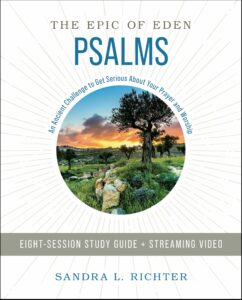I find the nature of sacred space in the ancient world fascinating. In his classic work Ancient Israel: Its Life and Institutions, the exceptional scholar of Old Testament Roland de Vaux discusses the topic at length. (De Vaux was also a French Dominican priest, director of Ecole Biblique in Jerusalem, and the first director of the Dead Sea Scrolls project.) Here we learn that sacred space in Israel’s world was never chosen simply for convenience or preference. Sacred space was the choice of the gods, and in Israel’s case the choice of the one, true God.
The place was typically indicated by some sort of manifestation of the god’s presence—his activity, his appearance, or his directive. So as we rehearse the locations of Israel’s central cult site, we find that Israel is directed first to Mount Ebal (Deut 11:29; 27:4), then Shiloh (Josh 18:1), and then to Jerusalem (1 Chr 15:3). As we will rehearse in the video teaching, Deuteronomy 12:1–5 makes it expressly clear that when Israel enters Canaan they are to dismantle the cult sites of the Canaanites, and replace those multiple sites with the one and only site of Yahweh. Why one site? To help our heroes hang onto the idea that there is only one God.
What did the ancients believe about these sacred sites? They believed that they could meet God there. That this place was the omphalos of the universe—a fancy word for “belly button.” Like a “belly button” the sacred precinct was that spot where heaven met earth, where the umbilical cord of the cosmos ushered divine power into human space. For the Israelites, this meant that the Jerusalem temple was the one place where a worshiper could be assured of encountering the Almighty. Why was this site (like Eden and the New Jerusalem to come) holy? Because God was there. And as we look back at Eden and forward to the New Jerusalem, we find that this space is marked by sacred rivers (which bring fertility to the earth), sacred trees, mountains (Mount Sinai and Mount Zion for example), pomegranates, and standing stones (masseboth)—all of which helped to mark the space as one where worship should occur. And if Israel destroys the cult sites of the surrounding nations, Israel will not be confused in her singular allegiance to Yahweh or tempted to offer her worship to other gods.
Keep in mind that Israel’s sacred space did not necessarily look different from that of their neighbors. But who it housed was very different. Rather than being occupied by a statue covered in gold and silver, the Holy of Holies was occupied by the all-powerful but invisible God. Rather than a god who was hungry and needed sacrifice to satisfy his cravings, the Jerusalem temple was occupied by a God who “owned the cattle on a thousand hills” and valued obedience far more than sacrifice (Ps 50:10; 1 Sam 15:22). As a result, the means by which Yahweh was worshiped and the expectations he placed on his people were dramatically different than worship practices in Canaan as well.
—
 Did you enjoy this entry? It’s an excerpt from Sandra Richter’s latest Bible study, Epic of Eden: Psalms. Epic of Eden brings our ancestors in the faith to the table where we learn from them in a cross-cultural experience bridging historical and modern day life. This eight-session study of the Book of Psalms masterfully mixes scholarly and practical teaching through the most-known wisdom Book of the Bible.
Did you enjoy this entry? It’s an excerpt from Sandra Richter’s latest Bible study, Epic of Eden: Psalms. Epic of Eden brings our ancestors in the faith to the table where we learn from them in a cross-cultural experience bridging historical and modern day life. This eight-session study of the Book of Psalms masterfully mixes scholarly and practical teaching through the most-known wisdom Book of the Bible.
Experience the Psalms with fresh connections to contemporary worship and devotional practices. Indulge in the biblical study of the Psalms from a scholar and former pastor. Letting Sandra do the “heavy lifting” of research and translation allows you to experience the Bible in a deeply sensitive way, answering the evergreen question, “so what does this have to do with me today?”



